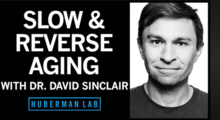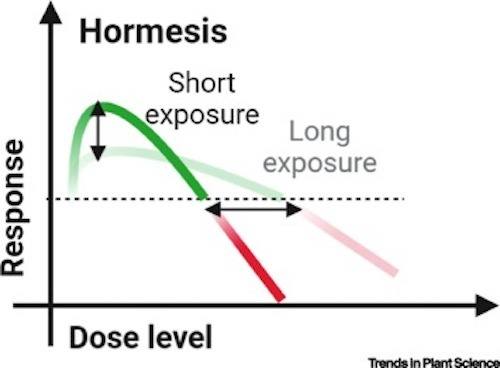The Biology of Reversing Aging with Dr. David Sinclair and Dr. Andrew Huberman

If you’re interested in reversing aging, watch Dr. Andrew Huberman interview renown anti-aging expert Dr. David Sinclair, who details his life extension protocols that has reduced his biological age by nearly 20 years.
The biology of reversing aging is the main topic of an eye-opening video below where Dr. Andrew Huberman interviews Dr. David Sinclair. You will learn how Dr. Sinclair reversed his chronological age of 50 to a biological age of 31.
Dr. Sinclair, the author of the book Lifespan: Why We Age & Why We Don’t Have To, is a tenured Professor of Genetics at Harvard Medical School and an expert researcher in the field of longevity. Dr. Huberman is an Associate Professor, Neurobiology at Stanford University and the founder of the Huberman Lab Podcast.
In this interview, Drs. Sinclair and Huberman discuss the cellular and molecular mechanisms of aging and what we all can do to ignite the biology of slowing and/or reversing aging. The topics, along with where they’re found in the video, are listed below. As you’ll see, the discussion touches on many aspects about what is currently known to slow and/or reverse the aging process, such as:
- Exercise
- Cold exposure
- Autophagy
- Activating mTOR and sirtuins
- The impact of blood sugar and food
- Hormesis
- Fasting
Huberman and Sinclair also discuss the future of longevity research and technology, and specific, actionable protocols, right down to the details of what to do and when. This information will provide you with an in-depth knowledge of the biology of reversing aging, or at minimum, to slow it down.
I’ve included a time stamp showing the location of topcis, and below the video, I weigh in on a few topics that I thought could use some clarification.
Also, I want to underscore what Dr. Sinclair announces at time stamp 02:05:40. His lab is working on a much less expensive bioage test that you can use to regularly measure how well you’re reversing aging. To get on his early access list, go here.
Topics Video Time Stamp
- What Causes Aging? The Epigenome 00:10:23
- Cosmetic Aging 00:15:53
- Development Never Stops, Horvath Clock and Your Face Predicts Bioage 00:17:15
- Puberty Rate as a Determinant of Aging Rate 00:20:12
- Fasting, Hunger & Food Choices 00:23:00
- Fasting Schedules, Long Fasts, (Macro) Autophagy 00:32:44
- Caffeine, Electrolytes 00:34:50
- Blood Glucose & the Sirtuins; mTOR 00:35:56
- Amino Acids: Leucine, “Pulsing” 00:37:55
- Metformin, Berberine 00:44:35
- Resveratrol, Wine 00:50:29
- What Breaks a Fast? 00:53:20
- Resveratrol, NAD, NMN, NR; Dosage, Timing 00:56:45
- Are Artificial Sweeteners Bad for Us? 01:09:10
- Iron Load & Aging 01:12:04
- Blood Work Analysis 01:15:05
- C-Reactive Protein, Cholesterol: Serum & Dietary 01:19:37
- Amino Acids, Plants, Antioxidants 01:26:02
- Behaviors That Extend Lifespan, Testosterone, Estrogen 01:33:45
- Neuroplasticity & Neural Repair 01:40:35
- Ice Baths, Cold Showers, “Metabolic Winter” 01:46:19
- Obesity & How It Accelerates Aging, GnRH 01:48:07
- Methylation, Methylene Blue, Cigarettes 01:52:10
- X-Rays 01:56:17
- Public Science Education, Personal Health 01:59:00
- The Sinclair Test You Can Take: www.doctorsinclair.com 02:05:40
The Biology of Reversing Aging: Huberman Interviews Sinclair
The Horvath Clock and Facial Skin Aging
At time stamp 00:7:15, Dr. Sinclair speaks about the Horvath Clock, which is the term given to a biological age assessment based on the work of Dr. Steven Horvath, a aging researcher, geneticist, biostatistician, and professor at the University of California Los Angeles.
The interview doesn’t delve very deep into what the Horvath Clock does, or where you can get an estimate of your bioage via the Horvath Clock or facial skin aging, so I’ll touch on that.
There are actually a few different Horvath Clocks, each based on different techniques and inputs. When someone subscribes to this blog, among several goodies I send is a Google spreadsheet that uses Dr. Horvath’s algorithm for his PhenoAge Clock. It uses just nine blood markers to predict biological age with a high degree of accuracy. You can learn more about this bioage test here and here.
The other Horvath Clocks are based on epigenetic mythelation markers. You may learn about those in my post, Discover Your Biological Age With These 4 Tests, Part 3: Epigenetic Age.
What about your face — what does that say about how you’re aging? To see about that, go here and learn how to use an artificial intelligence facial recognition model that uses a picture of your face.
Fasting and Autophagy
Fasting and autophagy topics begin at time stamp 00:23:00. There’s a lot of confusion about how long you have to fast to induce autophagy and just what constitutes a fast.
Autophagy works like a cellular waste recycling program helping cells clean damaged or misfolded proteins and large organelles, and turn them into functional cellular parts. The result is celluar rejuvenation. In many ways autophagy lays the foundation for a long and healthy cell life, which is why people serious about slowing down the aging process or reversing aging want to induce autophagy.
Fasting induces autophagy, but how long do you need to do that? Unfortunately, time restricted feeding (intermittent fasting) may only nudge autophagy into action, but not the deep cleanse autophagy called chaperone mediated autophagy that Ana Maria Cuervo at Albert Einstein College of Medicine discovered. This is because you need about three days of fasting to do that. And by fasting, I mean water, herbal tea and black coffee — nothing else. Dr. Sinclair is on an time restricted eating protocol whereby he does all his eating during a two-hour time frame in the evening. There are many health and longevity benefits to this, but igniting deep autophagy isn’t one of them.
Go here to see my series on intermittent fasting.
Blood Glucose & the Sirtuins; mTOR
At time stamp 00:35:56, Dr. Sinclair talks about the importance of keep your blood glucose (sugar) level low. This is because low blood sugar upregulates sirtuins, which are referred to as “longevity genes” given their ability to improve levels of NAD, a coenzyme essential for life, which decline as we age.
mTOR is another longevity pathway, this one activated by sensing how much protein (amino acids) are ingested. Now this one is tricky, because you would think that more protein is good, and it is if you’ve got sarcopenia (muscle wasting) going on, which most of the elderly do; however, too much of a good thing for too long a time can be bad, and so it is with keeping mTOR cranking. For longevity purposes, you want to downregulate mTOR, which fasting does.
How you accommodate your muscles’ need for protein without keeping mTOR burning is to pulse. Dr. Sinclair talks about how his longevity practice is basically a series of pulsing. Sometimes he’s fasting, sometimes he’s adding protein, for instance, when he’s lifting weights. But all the time he keeps his blood sugar level low.
Typically, the two blood sugar measurements are fasting blood glucose (taken in the morning before you eat) and HbA1c (a weekly average). The Life Extension Foundation says that ideally your fasting blood sugar should be less than 100 mg/dL.
Hormesis
Sinclair and Huberman talk about hormesis throughout the interview, because it’s a key factor in any longevity protocol.
You might have heard hormesis be described as something that doesn’t kill you but makes you stronger. But a better definition is that hormesis a dose-response phenomenon characterized by low-dose stimulation and high-dose inhibition, and has been recognized as representing an overcompensation for mild environmental stress. The beneficial effects of mild stress on aging and longevity have been studied for many years, and it’s now clear that the body’s longevity pathways are stimulated by physical stress, but not too much.
Examples of hormesis include exercise, fasting, cold baths and saunas (read my post, Dr. Rhonda Patrick: “Proof That Saunas Help Improve Heart Health and Healthspan”).
Another example of hormesis, the free radical. We’ve been taught that we need to extinguish free radicals with all the antioxidants we can get our hands on, but that’s been proven to be wrong, because our cells do better when they have to fight off free radical damage largely on their own. This is not to suggest that it’s better if you stop taking all antioxidants, but that the amount taken should not be an attempt to extinguish all free radicals. You might also elect to pulse them; meaning, one month on, one off, etc. For more about this, read my post, If The “Free Radical Theory of Aging Is Dead”, Should You Take Antioxidants?.
This hormesis principle even extends to plants. When plants undergo stress, they produce xenohormetic molecules. Xeno means between species. The idea is that when plants are stressed, they get better, stronger. Dr. Sinclair uses the example that a winemaker typically harvests grapes once the vines get dried out; it’s then that they’re full of resveratrol, because resveratrol is a plant defense molecule that is thought to activate sirtuin genes in a plant.
Your Takeaway
Let’s make this as simple as possible.
If you want to improve your healthspan, and put yourself on the path of reversing aging, choose among the following that’s easiest for you to do. Once that’s a habit, add another.
Shorten your feeding time. If you’re a big snacker, always munching on something, begin by stopping that. Then drop a meal, say breakfast or dinner. Or, if preferable, eat your normal three squares a day for five days, and under-eat for two days. Try fasting for 24 hours every month if you’re generally healthy. During fasting, it helps a lot to drink water, black coffee and herbal tea, as they help keep the hunger pangs away.
Add small stresses to your body. On a regular basis, but not all the time, stress your body. This can be fasting, as just mentioned, exercise and hot/cold exposure.
Supplement with metformin (or berberine), reservatrol (make sure it’s the trans-resveratrol kind) and NMN. As you heard in the interview, these are Dr. Sinclair’s basic supplement stack, which I explore further in the post, Dr. David Sinclair Supplements For A Long and Healthy Life.
Get on Dr. Sinclair’s Early Access List
Last Updated on June 21, 2022 by Joe Garma






